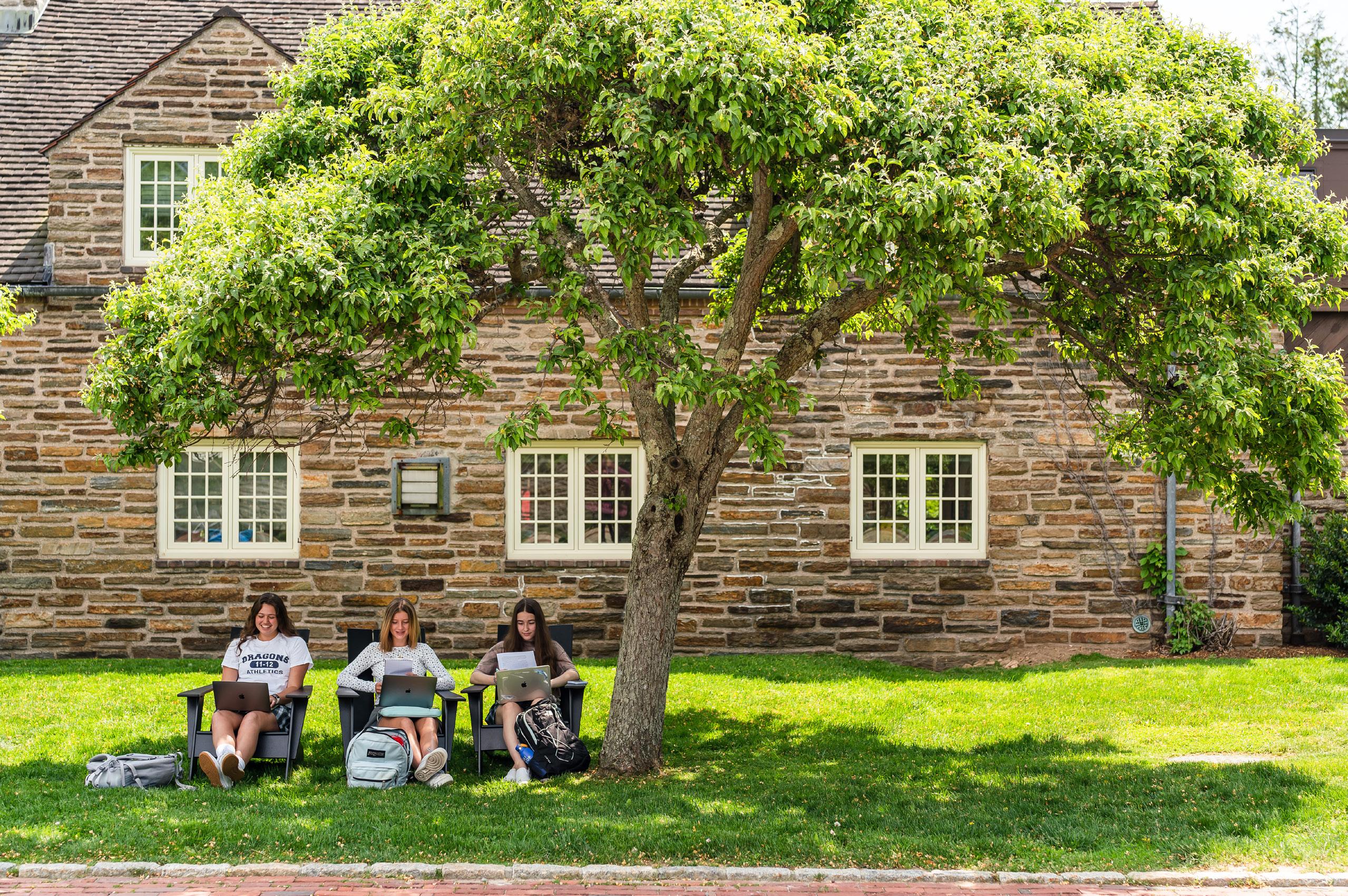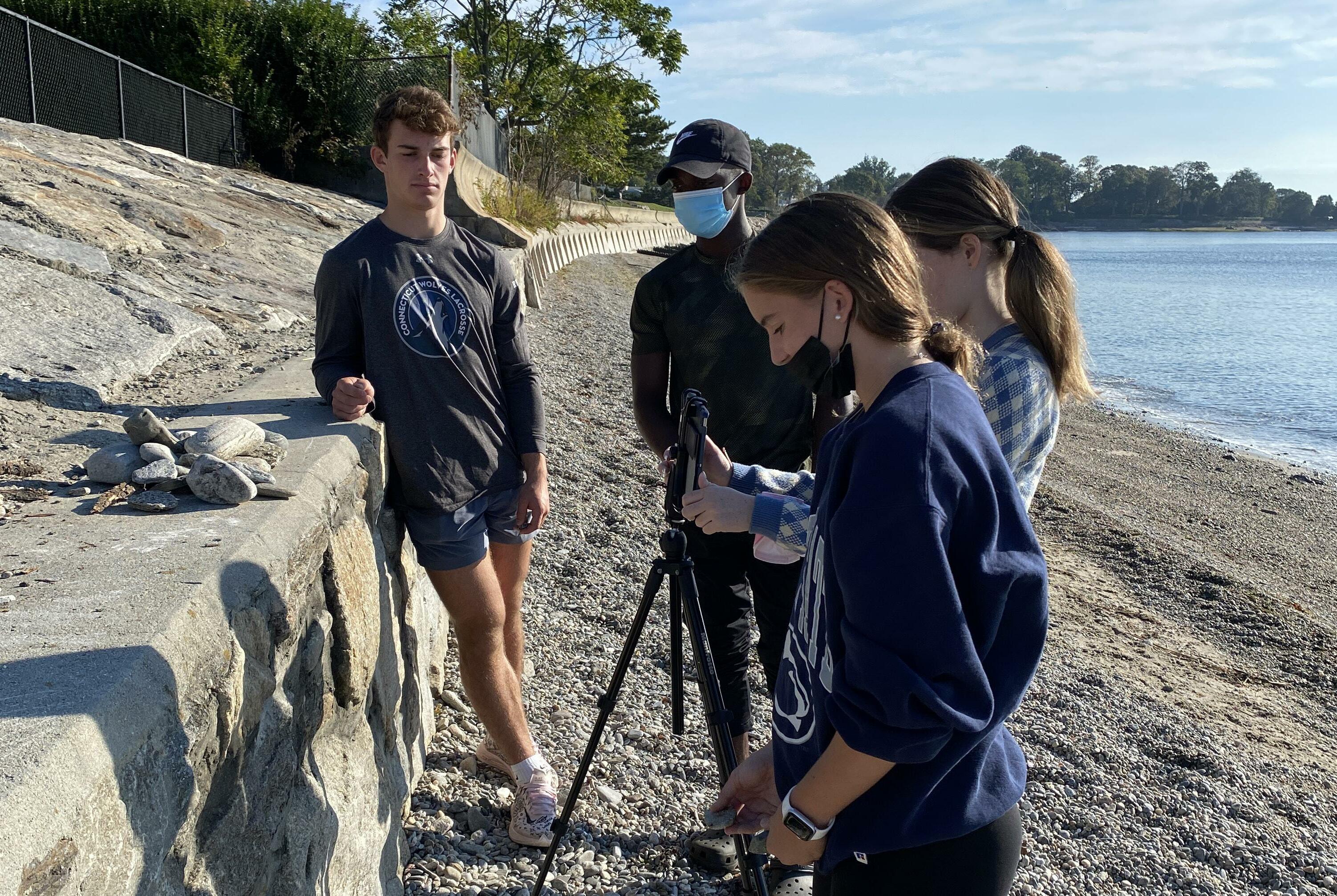
12 minute read
Performing Arts
performing arts
and depth of mathematical fields not formally covered as a part of the GFA curriculum in an area of the student’s interest. Topics could include, but are not limited to, number theory (prime/composite numbers, factors, multiples), topology (study of spatial relationships that are unaffected by changing shapes), graph theory (the study of connected and disconnected networks of nodes and edges), abstract algebra (the study of abstract number systems), and advanced calculus not covered in other mathematics courses. An Advanced Inquiry in Pure Mathematics includes a rigorous study of mathematical proof techniques. Completion of the Advanced Inquiry requires students to present their work. Open to 12th-graders; prerequisites:; AP Calculus (AB or BC) or AP Statistics (any of which may be taken concurrently). (1 credit; full year)
math850 aDvanCED InquIry: applIED mathEmatICS
An Advanced Inquiry in Applied Mathematics provides students with the opportunity to explore the application of mathematics to substantial contexts in the world in an area of the student’s interest. Topics could include, but are not limited to, the importance of number theory to cryptography, the application of geometric and topological ideas to visual arts and digital design, using graph theory to explore networks and network connectivity, or the use of mathematical modeling and statistical methods to study significant phenomena around the world. A student completing an Advanced Inquiry in Applied Mathematics will partner with faculty in the math department and, if appropriate, another department as it relates to the particular application of the mathematics. Completion of the Advanced Inquiry requires students to present their work to an audience. Open to 12th-graders; prerequisites:; AP Calculus (AB or BC) or AP Statistics (any of which may be taken concurrently). (1 credit; full year)
PERFORMING ARTS
EnS a ConCErt ChoIr
Vocal techniques, sight singing, and the art of performing in a vocal ensemble are incorporated into the study of a repertoire that includes both sacred and secular works from the Baroque through the 21st century, and from many different world cultures. Students perform throughout the year in school concerts and at community events. The Concert Choir is a non-auditioned choir and is open to any student in the Upper School. There is an audition for placement purposes only. (1 credit; full year)
EnS b ChambEr ChoIr
This is a smaller singing group, averaging between 10 and 16 members. Vocal techniques, sight singing, and the art of ensemble singing are stressed. The repertoire ranges from Renaissance music to music of the 21st century and encompasses a broad range of music from around the world. This choir also performs throughout the year in school concerts and at community events. Prerequisite: audition; ability to sight sing; Concert Choir (or transfer equivalent) for at least one year; departmental permission. (1 credit; full year)
EnS C ChambEr orChEStra
The goals of this course are to further enhance a student’s knowledge of orchestral repertoire from a variety of musical and cultural traditions and to reinforce ensemble and instrument skills. In addition, students are required to take playing tests, keep a practice chart, and participate in several concerts per year. Prerequisite: several years of experience playing a stringed instrument. (1 credit; full year)
EnS D WInD EnSEmblE
This group plays a wide variety of traditional concert band and jazz band music, including music from Broadway shows and movies, transcriptions and arrangements of orchestral literature, contemporary and classic big band jazz, marches, and an interesting mixture of music from around the world. This group performs in two or three concerts per year and attends at least one off-campus music festival. In addition to serving as the core ensemble for orchestral winds and percussion, Wind Ensemble students often form small jazz combos that perform frequently during the year. Prerequisite: several years of experience playing a wind or percussion instrument, guitar, electric bass, or piano; ability to read music is essential. (1 credit; full year)
muS250 muSIC tEChnology
This is a hands-on course in sound creation, sound design, and sound reinforcement. Using the computer and the synthesizer, students compose sound pieces in a variety of styles. One group project involves a collaborative effort with the Guild School in New York City. In this “Audio Book” project, students create books as audio files, complete with original music and sound effects, for the visually impaired students of the Guild School, as well as for our own Lower School students. Students are required to complete a number of individual and group projects that range from composing an aleatoric piece to writing and recording a public service announcement.
Students will use Garageband, Logic, FL Studio, and ProTools for recording and mixing. (1 credit; full year)
muS250 muSIC thEory
This course is a study of the fundamentals of music in terms of notation and analysis. Emphasis is placed on developing the rhythmic, melodic, and harmonic skills necessary to analyze pieces, compose original works, and arrange pieces for various ensembles. Emphasis is also placed on understanding and using traditional systems of tonal harmony through ear training, composing, and analysis. Creativity, keyboard skills, and compositional skills are stressed. Students are asked to work on individual pieces as well as group projects. Prerequisite: basic knowledge of music notation; participation in school music activities is highly encouraged. (1 credit; full year)
muS550 Jazz & bluES: thE hEart & Soul of amErICan popular muSIC
The history of American popular music of the 20th century is a chronicle of synchronous popular culture. The music that has come to be known as “jazz” is the ever-changing and evolving music of the American people. This semester inquiry defines and explores the various developmental styles of jazz: New Orleans jazz (Dixieland) and its roots; ragtime and stride piano; Chicago and the “Swing Era”; the Big Bands; bebop; the “cool school”; fusion and the avant-garde movement (free jazz); the education movement in jazz; and neoclassicism in contemporary jazz. Major figures in jazz, including Louis Armstrong, Charlie Parker, John Coltrane, Miles Davis, and Duke Ellington are studied, using their leadership roles to expand on the various movements in and permutations of jazz. The primary text for the course is Jazz Styles by Mark C. Gridley and David Cutler. Other readings are taken from the following: The Birth of Bebop by Scott Deveaux, Ken Burns’ Jazz: The Story of American Music, The History of Jazz by Ted Gioia, A New History of Jazz by Alyn Shipton, The Oxford Companion to Jazz by Bill Kirchner, and Jazz 101: A Complete Guide to Learning and Loving Jazz by John Szwed. Major sources of listening materials will include The Smithsonian Collection of Classic Jazz, Ken Burns’s The History of Jazz, and selected other recordings as applicable. Open to 11th- and 12th-graders. (.5 credit; 2nd semester)
muS550 hIStory of thE Symphony
This course will explore the origins and journey of the compositional form “the symphony.” Students will analyze major works in music history and the impact they had on the music scene when they were composed, and how they relate to the contemporary world today. These will include Haydn’s Symphony No. 104; Mozart’s “Symphony No. 40” and “Symphony No. 41” (Jupiter); Beethoven’s “Symphony No. 1,” which caused major controversy after its premiere; Beethoven’s “Symphony No. 9” (which contains the famous “Ode to Joy”); Brahms “Symphony No. 1”; and Dvorak’s “Symphony No. 9” (From the New World), which is considered by some the first piece of “American” music. There will be lectures by conductors from local symphonies, and field trips to hear symphony concerts, including the American Chamber Orchestra, one of the groups conducted by GFA’s Chris Hisey. Open to 11th- and 12th-graders. (.5 credit; 2nd semester)
muS650 aDvanCED muSIC thEory
This course integrates aspects of melody, harmony, texture, rhythm and form, history, and style. Aural skills developed include sight singing, keyboard harmony, and melodic, rhythmic and harmonic dictation. Students will read, notate, and compose music. In-class performance is part of the learning process. Students are expected to demonstrate a high level of proficiency in all areas of music theory. Prerequisite: Music Theory and/or departmental permission. Students are encouraged to sit for the AP Music Theory Exam. (1 credit; full year)

muS750 InquIry: CompoSIng & arrangIng
This course focuses on composing and arranging music in various styles for both vocal and instrumental use. A study of classical, jazz, and folk forms is included. Students are encouraged to perform (or have performed) their works at assemblies and concerts, to enter their works in the Connecticut Music Educators’ Association sponsored composers’ competition and other relevant competitions. Prerequisite: Music Theory and/or AP Music Theory; departmental permission. Open to 11th- and 12th-graders. (.5 credit; full year)
muS750 InquIry: muSIC pErformanCE
This inquiry brings together the teacher and the student to plan, research and prepare for a short recital in April or May. The planning and research are intended to select compositions from appropriate periods of music history, to listen to a broad range of recordings and live performances, and to submit short papers about the composers and compositions selected for performance. Selections chosen for performance need not all be solo works — there is a rich tradition of ensemble playing which would be ripe for exploration and programming. Open to 11th- and 12th-graders. (.5 credit; full year)
muS850 aDvanCED InquIry: muSICal pErformanCE, CompoSItIon, or ConDuCtIng
This course provides a path for the dedicated musician to follow a passion as a performer, creator, or director of music at its most advanced level. The prospective participant will have demonstrated a commitment to and intensive involvement in music. The student will design a project that will involve creating, performing, or directing music, musical instruments, music notation, or may design a mentoring program with a Lower School musician. The projects could range from a recital to designing and creating a musical instrument and notation for that instrument, to creating an original musical theatre work, to a thorough analysis of a major musical work culminating in a presentation to a select group of students and adults. Prerequisite: one credit of music courses, may be taken concurrently; departmental permission. Open to 12th-graders. (1 credit; full year)
thE250 IntroDuCtIon to thEatrE DESIgn
In this course, students will learn to collaborate with playwrights and/or directors to design sets, props, lighting, projections, and costumes that further the vision for the piece. A rotating set of guest lecturers will give stu-
dents brief lessons in the fundamentals such as set, prop, lighting, projection, and costume design. Guest lecturers will focus on the collaboration that incorporates the visual aspect of storytelling, with an emphasis on the way decisions in technical theatre can dictate emotional tone, character development, and a sense of place and time period. Students in this course will learn concurrently with Intermediate Theatre Design students. (.5 credit, 2nd semester)
thE450 IntErmEDIatE thEatrE DESIgn
In this course, students will build on the knowledge and skills they gained at the introductory level of theatre design. They will have the opportunity to focus their work in specific areas of theatre design such as custom, lighting, sound, and set design. They will be responsible for elements of the design process in both the winter showcase and the spring show. Guest lecturers will focus on the collaboration that incorporates the visual aspect of storytelling, with an emphasis on the way decisions in technical theatre can dictate emotional tone, character development, and a sense of place and time period. Students in this course will learn concurrently with students in Introduction to Theatre Design. Prerequisite: Introduction to Theatre Design; departmental permission. (.5 credit, 2nd semester)
thE450 IntErmEDIatE thEatrE
This course allows students with prior introductory exposure to theatre to begin their theatre work in the Upper School. The course emphasizes the building blocks of acting including correct vocal production, and movement for the stage. Poetry, monologues, and improvisation will be used to help open a creative link to theatrical storytelling. Students explore theatre more deeply with an emphasis on first-hand experience by going on a field trip to see a play outside of school, and they will be exposed to world theatrical literature. Performance in the spring in the Upper School or elsewhere in the GFA community is a feature of this class. Students in this course will learn concurrently with students in introduction to theatre. Prerequisite: Introduction to Theatre in Middle School, prior engagement in a show, or departmental permission. (.5 credit; full year)
thE550 broaDWay & bEyonD
This course combines a classic “survey style” history of how the American Musical was born. The course continually re-creates itself with hands-on performances. Students may have the opportunity to sing, act and dance pieces from representative musicals. This course will combine the historical perspective with the practical aspects of performing parts of musical productions— remarkable iconic works that have come to define the American Broadway Musical. Field trips, including seeing a show in New York, will be part of this class, and guests will come to share their expertise in the profession with the students. Open to 11th- and 12th-graders. (.5 credit; 1st semester)
thE650 aDvanCED thEatrE
This course exposes students to three areas of advanced theatre: companies, production, and directing. Students begin with an exploration of influential theatre companies such as those of Shakespeare and Molière. How did these creative artists come together to make what we now consider “classic” theatre? What is the evolution of the plays they created, and what was the cultural impulse behind them? The course then turns to the study of all production elements and their use. Students learn about sets, lighting, sound, and costumes as primary elements in focusing attention and creating mood and character in a theatrical production. The course then explores the relationship between the director and designers to define the look and feel of a final production. Students direct one another after exploring the techniques and skills involved in creating a production as a director. Students engage in scene work to practice proper vocal and movement techniques as well as the development of the relationship between actors and directors. Students in this course participate in performance opportunities around the school, when and where they present themselves. Prerequisite: Intermediate Theatre, Theatre Design or departmental permission. (1 credit; full year)
thE750 InquIry In thEatrE anD DESIgn
This class is a guided study of a student’s passion for Theatre performance, design, playwriting or direction. It allows students to partner with a teacher in close connection while encouraging the freedom of innovative expression. The focus will be on the spark of creation inherent in the formative process and the work may be from any existing play or an original piece fashioned by the student. Prerequisite: Theatre classes in 200–600 levels. Open to 11th- and 12th-graders. (.5 credit; full year)
thE850 aDvanCED InquIry In thEatrE: aCtIng, DIrECtIng, playWrItIng or DESIgn
This course is designed to give students the opportunity to build on the foundation of the curricular offerings at GFA through an independent creative project. Inspired by the idea that students and teachers always pass cyclical trans-









